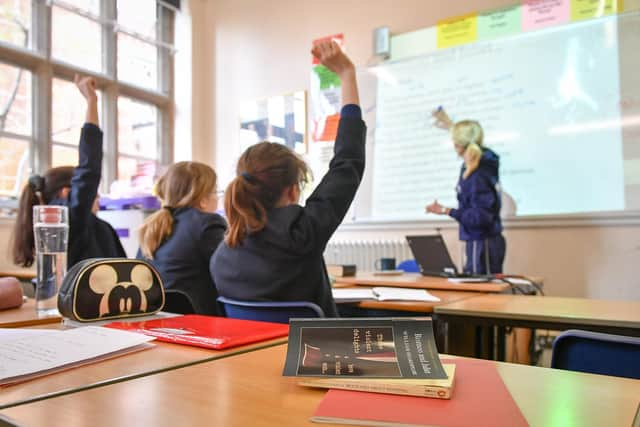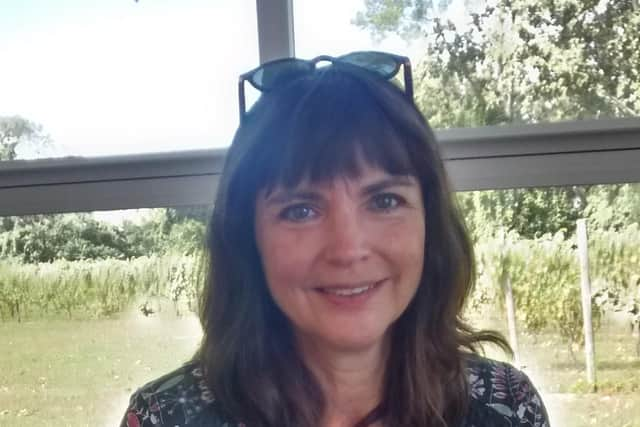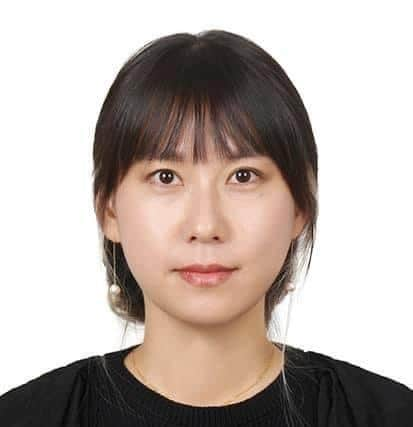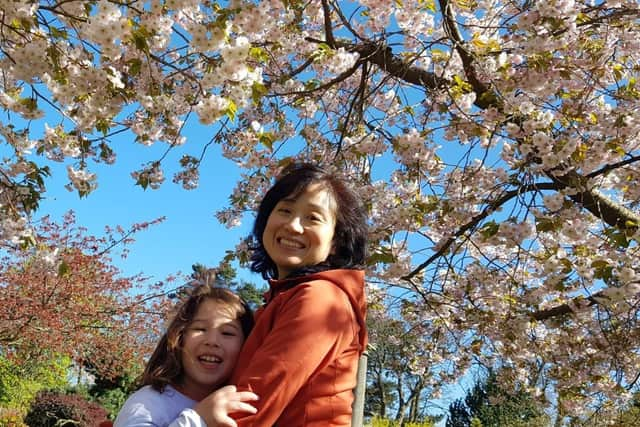How do countries with the world’s best-ranked education systems run their schools, and how do they compare to Scotland?
Here, in part two of an exclusive five-part series, we take a look at which countries perform best in terms of overall educational achievement and find out how they operate.
The Global Citizens for Human Rights' annual study measures ten levels of education from early childhood enrolment rates to adult literacy. The body ranks the top five education systems as South Korea, Japan, Denmark, the Netherlands and Australia.
Advertisement
Hide AdAdvertisement
Hide AdMichele Schweisfurth, professor of international education at the University of Glasgow, said the top performing systems had little in common.


She said: "Looking at that list, there is no silver bullet. There is nothing that all these countries have in common. They are wildly different from each other and have completely different education traditions. Japan and South Korea are considered Confucian heritage cultures, whereas Denmark and the Netherlands are European and Australia is a settler colony.”
Prof Schweisfurth added: "These are wildly different places – some are small countries in terms of territory or population, some are big, some of the systems are centralised, some of them are federal. Some of them use high stakes testing, some of them do not. Some of them spend more on education than the OECD [Organisation for Economic Co-operation and Development] average, some spend less.
"So if an education policymaker, or indeed a parent, were trying to decide what to do, or where to live, there's nothing in these lists to help.”
While Asian countries like South Korea, which is the top performer on this and many other rankings, and Japan are heavily academically focused, relying on high-stakes tests, other countries such as the Netherlands take a more holistic approach to education, often focusing on child-led learning such as the Montessori method in the early years.


The Scottish Government is looking at how it can overhaul the Scottish exams system following recommendations from an OECD report it commissioned two years ago, which suggested reducing reliance on exam-based assessment and moving towards a more coursework based system for older pupils.
Prof Schweisfurth said: “South Korea is an amazing success story because not that long ago, post World War Two, literacy rates were really low and it was a very uneducated population. So they've turned things around in a generation or two in a way that is absolutely amazing.
"It could be a cultural phenomenon, that there's so much importance placed on education that kids are going to be successful whatever because they're hot housed at home and they're sent to additional lessons and supplementary tutoring.”
Advertisement
Hide AdAdvertisement
Hide AdHowever, she pointed to the risks associated with pressure on young people. In South Korea, most older pupils study at private schools in the evenings – after a full day in the classroom.


Prof Schweisfurth said: “South Korea is definitely known for that [high pressure] and there are concerns there about things like high suicide rates among kids and the huge pressure that they're under. Japan used to have that problem, too. They've really pedalled back from the intensity that they used to have in their system exactly for that reason.”
However, Prof Schweisfurth said she believed different cultures had different expectations – and a different ability to deal with systems which would seem foreign to those in other countries.
She describes a study carried out of pre-schools in the US and Japan, where videos of time in classrooms were shown to parents from other countries. American parents were shocked by the number of children in a class with one teacher, while Japanese parents felt in the US, there was too much involvement from adults, meaning the young children would not be able to work things out for themselves.
Prof Schweisfurth said: “It's a cultural phenomenon and there are different expectations about relationships between pupils and relationships between pupils and teachers. She described the “pedagogical nexus”, which is the way all the things in a system fit together and fit with what happens in classrooms.


“It's when you don't get a coherence – when you don't get that fit – that you tend to have problems, which is why reforms often don’t go the way it's anticipated they will go,” she said. “They can be very well meaning, but they're messing with the pedagogical nexus. You can blame teachers for not implementing it properly or whatever, but at the end of the day, if it's not a really good fit, with culture or resources or with structures, it can backfire.
"It's really difficult to get clear lessons from these rankings that can be implemented in other places. Perhaps that's the most important thing of all – that each system is successful in its own way, in its own place, in its own right.”
South Korea
Education spending is 4.5 per cent of GDP
A South Korean education is highly rated in a lot of different ranking systems. A lot is expected of young people there, many of whom study with private tutors and out-of-school classes on top of their ordinary school day.
Advertisement
Hide AdAdvertisement
Hide AdThe nation consistently scores highly in literacy and numeracy comparisons and has one of the world's highest-educated labour forces among OECD countries.
The system is divided into three parts: six years of primary school, followed by three years of middle school and then three years of high school.
In recent years, the Korean government has tried to reform the system to reduce pressure on students. While holidays for summer and winter exist, there are ten optional half days of school at the beginning and end of each holiday break, and the majority of Korean students attend both. In some regions, there are limitations to the operating hours of private schools – known as hagwon – which in the past, used to run until the early hours of the morning. A typical school day in a standard Korean high school begins at 8am, and finishes between 4pm and 5pm.
Jee Hazleton is a teacher from Busan, South Korea. She worked in a hagwon for ten years and is now a private tutor in English.
“Born in the 1980s, I went to public schools with a bit of tutoring and went to college,” she said. “I can safely say that now pretty much every single student takes some kind of extra tutoring, many of them at a private tutoring school called a hagwon.
"What kind of tutoring they choose depends on their parents’ wealth level. There are after-school programs at public schools, which are the cheapest at under $100 (£83) per month; hagwons, where there are four to eight kids in one class, which costs between $150 to $350 (£124-290) a month and one-on-one private tutoring, which costs $300 to $700 (£249-580) usually, but sometimes even over $1,000 (£830) a month. One of the reasons why even very young children – aged five to ten – take extra classes is that their parents both work till dinner time and they don’t have anywhere to go.
“Korea has been always really focused on academic achievement since it was the only way people could change or improve their lives since old dynasties. So this tutoring system has a really long history, changing its forms in different times.
“In ordinary schools, there are around 20 students in one class these days, but a lot of this is due to the fact we have the lowest birth rate in the world and numbers are dropping. Twenty years ago, it was around 40 and they had to separate morning classes and afternoon classes in elementary schools because there were too many kids.
Advertisement
Hide AdAdvertisement
Hide Ad“The whole system is basically the game of who goes to a good college. There are two ways to enter a college now; apply with your 2.5 years in high school, or apply with Korean SAT (Sunyeung). Korean SAT, at least in English, has got so much harder compared to 20 years ago, and it’s pretty much impossible for students to get high grades without extra help.
“I don’t have children, but I’ve taught some of my students longer than ten years and feel they’re like my nephews and nieces. I do feel bad for them. The level of stress and pressure they get is really high.
“Although I wouldn’t say they don’t have any childhood or teenage joy because of that, but I do think it is one of the biggest reasons why the younger generation often chooses not to have children or get married.”
Japan
Education spending is 3.1 per cent of GDP.
Class sizes in Japan tend to be large compared to the UK, with an average of about 38 students per class. At the age of 15, students can choose specialised streams, such as science or business.
Surveys carried out by the OECD have previously found Japanese children do not ever skip classes and are rarely late as punctuality is taken seriously in Japanese schools. Schools rarely employ cleaners, as students are expected to clean the classrooms at the end of every school day.
Sports clubs and other interest groups usually take place after the school day. In addition to standard clubs common in UK schools, there are often numerous student clubs available revolving around Japanese traditional sports and culture, such as judo, kendo (Japanese swordsmanship), sado (Japanese tea ceremony), kado (Japanese flower arrangement) and shodo (Japanese calligraphy).
The school year begins in April and ends in March the following year.
Kumi Brown, from Ibaraki province in Japan, lives in Edinburgh with her husband Andy and daughter Emily, ten.
Advertisement
Hide AdAdvertisement
Hide Ad"There are exams for children to go to secondary school and how well you do depends on which school you go to,” she said. “But they do a lot of tests from primary school, so they are used to them and know what level they are at. Here, when I go to a parents’ evening, they tell me ‘she is doing well, she’s happy in class’. In Japan, it is more about the score you received on the last test and what level you got and what you should be trying to get.
“In class, children sit in rows facing the blackboard. Although Japan has a lot of technology, schools are still more traditional, with blackboards rather than whiteboards. The pupils are responsible for cleaning the classroom, the schools don’t employ cleaners. After lunch every day, which they eat at their desks, they have to push the tables back and mop the floor before the teacher gets back. They all have to bring their own cloth, which they make at home with their name on it.
"After school, when they get older, they have clubs. They used to be mainly academically focused, but now they want children to do sports, so it is a mix. They tend to get quite a lot of homework, then parents often do an hour or so of extra study in the evenings with them as well. Some people send their children to private schools and tutors in the evenings, especially in the city.”
Denmark
Education spending is 6.8 per cent of GDP.
Primary and lower secondary schooling is not separated in Denmark, and pupils usually attend the same school from the first form through to the ninth, when they are 15. If they choose to go on to upper secondary, they move to a different school and remain there until they are 19.
Children are taught by the same teacher for multiple years in primary and lower secondary, usually changing teacher only once or twice. Classes often remain broadly the same throughout school, meaning children can graduate from school in class with the same children they started school with almost a decade earlier.
Private school fees are supported with a voucher system, which allows parents to subsidise the costs with a contribution from the state. Danish private schools charge modest tuition fees compared to the UK and are not run for profit.
Mads Fischer-Moller is from Lyngby, outside Copenhagen. Two years ago, he moved to Edinburgh with his wife Freja and three children Gustav, 12, Louis, ten and Ingrid, seven.
"School is earlier than in Scotland, the children start at 8am and finish around 3pm, but the difference is that almost all children go to after-school club, which is high quality childcare at the school and your children are happy because they are spending time with all of their friends,” he said. “It means parents don’t have to rush home from work.
Advertisement
Hide AdAdvertisement
Hide Ad“In Denmark, there is a cap on class sizes. I think it's 28 kids per class. However, local councils can choose to have even lower caps, and that's something that the policymakers fight in their election campaigns. Where we lived, it was lower, at around 24 or 25.
"In Denmark, there was a little bit more formalised close contact between school and parent and the communication felt more professionalised. The biggest difference is that in primary school – up to 15 – they have the same group of around three teachers that will be with the class for three years. They teach as a team, some teachers for some subjects, some for others, and I think that works well as it means that if a child doesn’t click with one teacher they have others, it’s not the same person all day, like here.
"In Scotland, the big change happens at age 12 with a change from primary to secondary. But in Denmark, that would be age 15. At that point, not everyone goes to the same sort of school – some go to a business college, some go to more of an academic high school, or you could just say ‘OK, I'm done with school, I want to do skills and learn to be a carpenter’.
The Netherlands
Education spending is 5.4 per cent of GDP.
Some primary schools in the Netherlands are based on a particular educational philosophy, such as the Montessori method. At the end of elementary school, pupils sit a test not unlike the eleven-plus previously used in the UK, called the Citotoets. However, it is not only the result of the test that determines what kind of high school a pupil should attend – it is a decision made with parents and their primary school teacher.
Two high school options are available – one vocational and the other more academic. It is possible for pupils to move between the two if their motivation or ability changes through their teenage years. Private schools are uncommon in the Netherlands, with even the Dutch royal family usually attending state schools.
Australia
Education spending is 5.1 per cent of GDP.
Around 40 per cent of Australian children attend non-government run schools, two thirds of which are Catholic. Payments are usually required for tuition at non-government schools, although some funding comes from the Australian government, while many government schools ask parents for payment of “voluntary” fees towards certain expenses.
In some rural areas, particularly in New South Wales, primary and secondary schools are combined to create a “central school”. A school year in Australia starts in January and finishes in December.
Liz de Prose lives in Perth, Australia, with husband Jonas and children Annalise, seven, and Monty, five.
Advertisement
Hide AdAdvertisement
Hide AdShe says: “The school year in Australia starts in February, so my daughter is about to start Year Three and my son has just finished what is called Pre-Primary. They start school here slightly younger than in Scotland – pre-primary is compulsory, which is full-time school. It’s a little more relaxed, they have tables and a lot of mat time in front of the teacher and move around. However, once they start Year Two, it’s more formal with classroom-style tables, where they sit facing the front.
"From Year Three, they start doing exams, in a system called the NAPLAN and from then on, they sit exams every year through high school. Recently, there's been a lot of people trying to push back, saying that they shouldn't be doing that plan from so early, because it's not fair on the children to put the pressure on them at such a young age.
"What I like is that they do a lot of extra curricular activities within the school curriculum. Two terms of the year, they can choose an activity that they do during the school day. Last year, my daughter did puppetry, learning to make puppets and put on a show, but they do things like cooking as well. They also have a dance scheme that is part of the curriculum. All the children have to do it, they learn the routine and put on a show at the end of the term. It's great as it means even the introverted kids join in when they see everyone is doing it. At my children’s school, the feeling is very much that if one person wins, everyone wins. It being Australia, sport is very important, but science is also seen as cool.
"When they go to high school, there are specialist subjects they can choose from on top of normal subjects, such as marine biology, music or engineering. I think it’s really great that they can take the subjects they are interested in from Year Seven, rather than waiting to specialise when they are older.
"There is a backlash against the formalised learning and saying it’s outdated and I do think Australia needs to have another think and re-evaluate our education system and look at how it needs to be now.”
Comments
Want to join the conversation? Please or to comment on this article.